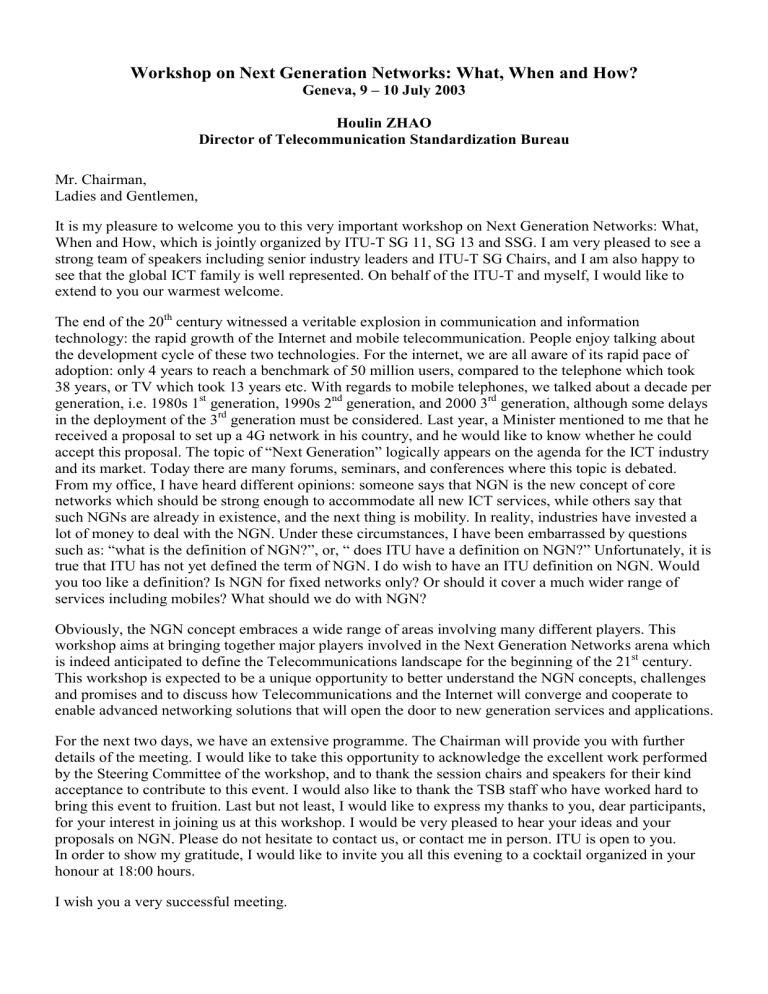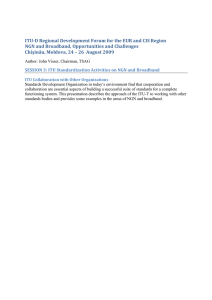Workshop on Next Generation Networks: What, When and How?

Workshop on Next Generation Networks: What, When and How?
Geneva, 9 – 10 July 2003
Houlin ZHAO
Director of Telecommunication Standardization Bureau
Mr. Chairman,
Ladies and Gentlemen,
It is my pleasure to welcome you to this very important workshop on Next Generation Networks: What,
When and How, which is jointly organized by ITU-T SG 11, SG 13 and SSG. I am very pleased to see a strong team of speakers including senior industry leaders and ITU-T SG Chairs, and I am also happy to see that the global ICT family is well represented. On behalf of the ITU-T and myself, I would like to extend to you our warmest welcome.
The end of the 20 th century witnessed a veritable explosion in communication and information technology: the rapid growth of the Internet and mobile telecommunication. People enjoy talking about the development cycle of these two technologies. For the internet, we are all aware of its rapid pace of adoption: only 4 years to reach a benchmark of 50 million users, compared to the telephone which took
38 years, or TV which took 13 years etc. With regards to mobile telephones, we talked about a decade per generation, i.e. 1980s 1 st generation, 1990s 2 nd in the deployment of the 3 rd
generation, and 2000 3 rd generation, although some delays
generation must be considered. Last year, a Minister mentioned to me that he received a proposal to set up a 4G network in his country, and he would like to know whether he could accept this proposal. The topic of “Next Generation” logically appears on the agenda for the ICT industry and its market. Today there are many forums, seminars, and conferences where this topic is debated.
From my office, I have heard different opinions: someone says that NGN is the new concept of core networks which should be strong enough to accommodate all new ICT services, while others say that such NGNs are already in existence, and the next thing is mobility. In reality, industries have invested a lot of money to deal with the NGN. Under these circumstances, I have been embarrassed by questions such as: “what is the definition of NGN?”, or, “ does ITU have a definition on NGN?” Unfortunately, it is true that ITU has not yet defined the term of NGN. I do wish to have an ITU definition on NGN. Would you too like a definition? Is NGN for fixed networks only? Or should it cover a much wider range of services including mobiles? What should we do with NGN?
Obviously, the NGN concept embraces a wide range of areas involving many different players. This workshop aims at bringing together major players involved in the Next Generation Networks arena which is indeed anticipated to define the Telecommunications landscape for the beginning of the 21 st century.
This workshop is expected to be a unique opportunity to better understand the NGN concepts, challenges and promises and to discuss how Telecommunications and the Internet will converge and cooperate to enable advanced networking solutions that will open the door to new generation services and applications.
For the next two days, we have an extensive programme. The Chairman will provide you with further details of the meeting. I would like to take this opportunity to acknowledge the excellent work performed by the Steering Committee of the workshop, and to thank the session chairs and speakers for their kind acceptance to contribute to this event. I would also like to thank the TSB staff who have worked hard to bring this event to fruition. Last but not least, I would like to express my thanks to you, dear participants, for your interest in joining us at this workshop. I would be very pleased to hear your ideas and your proposals on NGN. Please do not hesitate to contact us, or contact me in person. ITU is open to you.
In order to show my gratitude, I would like to invite you all this evening to a cocktail organized in your honour at 18:00 hours.
I wish you a very successful meeting.
Thank you for your attention.
- 2 -
